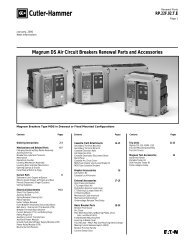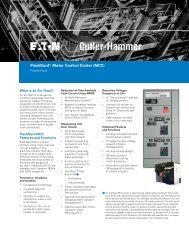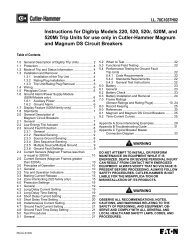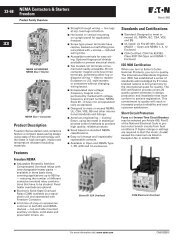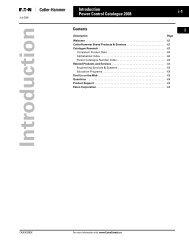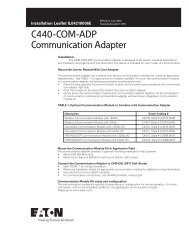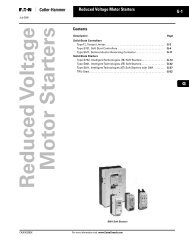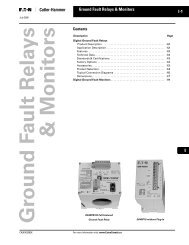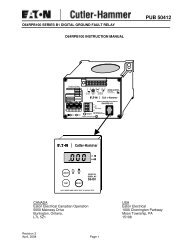M-Maxâ„¢ Series Adjustable Frequency Drive - Eaton Corporation
M-Maxâ„¢ Series Adjustable Frequency Drive - Eaton Corporation
M-Maxâ„¢ Series Adjustable Frequency Drive - Eaton Corporation
You also want an ePaper? Increase the reach of your titles
YUMPU automatically turns print PDFs into web optimized ePapers that Google loves.
Parameters<br />
On the constant three-phase AC supply, the three-phase<br />
asynchronous motor has a constant rotor speed (n1 , P7.3,<br />
rating plate specifications) according to the number of pole<br />
pairs and input frequency. The slip here represents the<br />
difference between the rotating field of the stator and that of<br />
the rotor. In static operation, the slip is constant.<br />
Load changes [1] at the motor shaft cause a larger slip ( n)<br />
and thus a reduced rotor speed [2]. In controlled operation<br />
(V/f-characteristic), the frequency inverter cannot<br />
compensate this load-related speed difference. The speed<br />
behavior of the motor is even, as in a constant AC supply.<br />
Speed Behavior without Slip Compensation<br />
M<br />
M 2<br />
M 1<br />
n 2<br />
n<br />
n1 In “Speed control” mode (P11.8 = 1), the frequency inverter<br />
can compensate these load-related deviations. From the<br />
measured voltage and current values of the stator winding<br />
(u 1 , i 1 ) the internal motor model calculates the required<br />
manipulated variables for the flux variable i μ and the torque<br />
variable i w . In the equivalent circuit diagram of the<br />
three-phase motor, the load-related slip is shown as the<br />
resistance R’ 2 /s. In idle operation without a load, this<br />
resistance approaches infinity, and approaches zero as the<br />
load increases.<br />
2<br />
1<br />
108 M-Max <strong>Series</strong> <strong>Adjustable</strong> <strong>Frequency</strong> <strong>Drive</strong> MN04020003E—April 2011 www.eaton.com<br />
n<br />
Equivalent Circuit Diagram for an Asynchronous Motor<br />
X 1<br />
i 1<br />
R 1<br />
Item<br />
Number Description<br />
1 Stator winding<br />
2 Air gap<br />
3 Transformed rotor winding<br />
An exact calculation requires the precise rating specifications<br />
of the motor (parameter group 7). The speed control (P11.8 =<br />
1) can then compensate the load-related slip deviations. The<br />
simple illustration shows that, as the load torque increases<br />
[1], the resulting speed reduction is compensated by an<br />
increase in the output frequency [2] (see figure below).<br />
X' 2<br />
Speed Behavior with Slip Compensation<br />
M<br />
u 1<br />
M 2<br />
M 1<br />
i m<br />
X h<br />
i w<br />
1 2 3<br />
2<br />
1<br />
n 1<br />
n<br />
R' 2<br />
s




